
Building products manufacturer JELD-WEN (NYSE: JELD) reported Q2 CY2025 results topping the market’s revenue expectations, but sales fell by 16.5% year on year to $823.7 million. The company’s full-year revenue guidance of $3.3 billion at the midpoint came in 3.8% above analysts’ estimates. Its non-GAAP loss of $0.04 per share was 61.9% above analysts’ consensus estimates.
Is now the time to buy JELD-WEN? Find out by accessing our full research report, it’s free.
JELD-WEN (JELD) Q2 CY2025 Highlights:
- Revenue: $823.7 million vs analyst estimates of $810.3 million (16.5% year-on-year decline, 1.7% beat)
- Adjusted EPS: -$0.04 vs analyst estimates of -$0.10 (61.9% beat)
- Adjusted EBITDA: $39 million vs analyst estimates of $30.6 million (4.7% margin, 27.5% beat)
- EBITDA guidance for the full year is $185 million at the midpoint, above analyst estimates of $146.6 million
- Operating Margin: -1.7%, down from 0.5% in the same quarter last year
- Free Cash Flow Margin: 1.3%, similar to the same quarter last year
- Organic Revenue fell 13% year on year, in line with the same quarter last year
- Market Capitalization: $378.7 million
"While the second quarter brought continued challenges, we managed the uncertainty effectively, delivering cost reductions across the business," said Chief Executive Officer William J. Christensen.
Company Overview
Founded in the 1960s as a general wood-making company, JELD-WEN (NYSE: JELD) manufactures doors, windows, and other related building products.
Revenue Growth
Reviewing a company’s long-term sales performance reveals insights into its quality. Any business can put up a good quarter or two, but the best consistently grow over the long haul. JELD-WEN’s demand was weak over the last five years as its sales fell at a 3.7% annual rate. This wasn’t a great result and suggests it’s a low quality business.
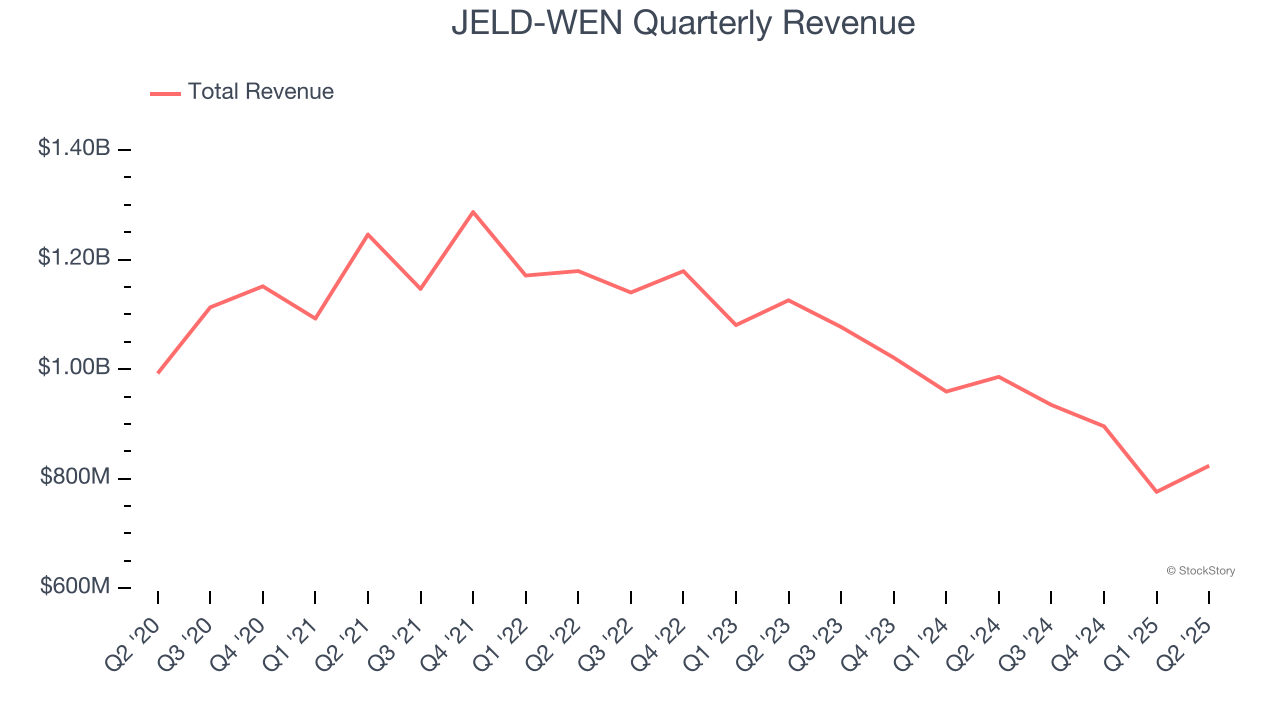
We at StockStory place the most emphasis on long-term growth, but within industrials, a half-decade historical view may miss cycles, industry trends, or a company capitalizing on catalysts such as a new contract win or a successful product line. JELD-WEN’s recent performance shows its demand remained suppressed as its revenue has declined by 12.9% annually over the last two years. 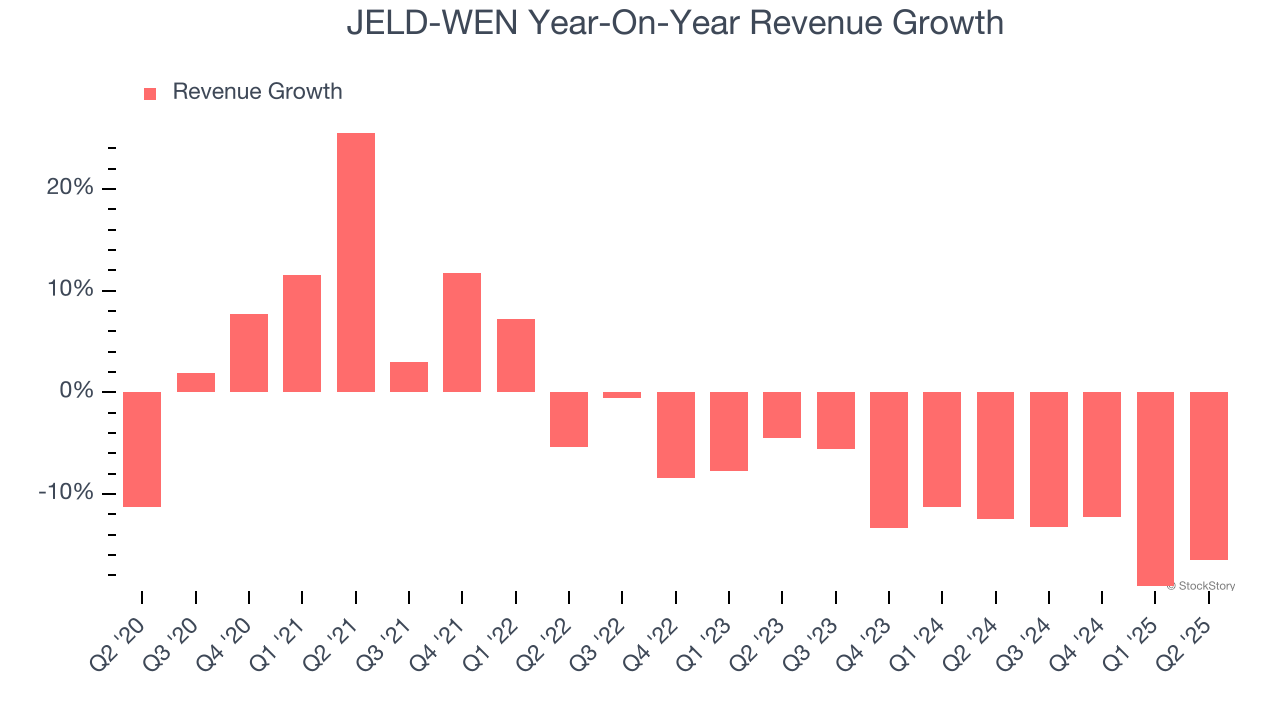
We can better understand the company’s sales dynamics by analyzing its organic revenue, which strips out one-time events like acquisitions and currency fluctuations that don’t accurately reflect its fundamentals. Over the last two years, JELD-WEN’s organic revenue averaged 12.6% year-on-year declines. Because this number aligns with its two-year revenue growth, we can see the company’s core operations (not acquisitions and divestitures) drove most of its results. 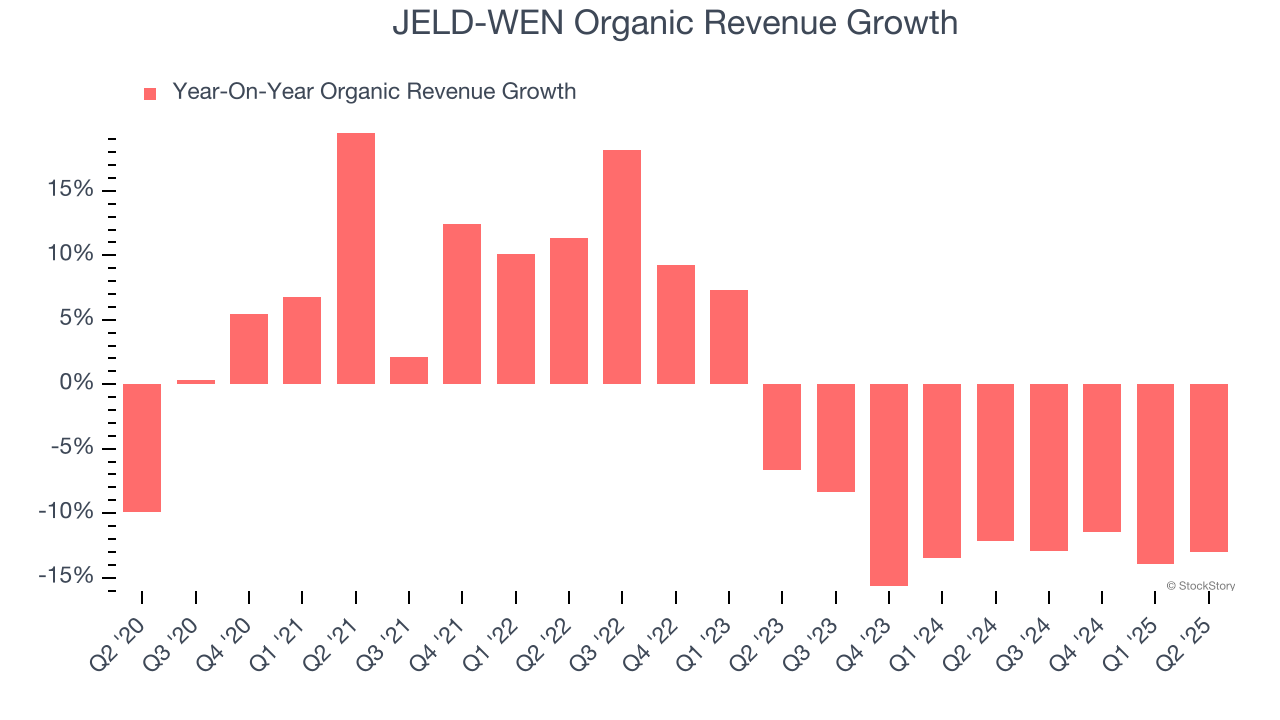
This quarter, JELD-WEN’s revenue fell by 16.5% year on year to $823.7 million but beat Wall Street’s estimates by 1.7%.
Looking ahead, sell-side analysts expect revenue to decline by 6.5% over the next 12 months. While this projection is better than its two-year trend, it’s hard to get excited about a company that is struggling with demand.
Today’s young investors won’t have read the timeless lessons in Gorilla Game: Picking Winners In High Technology because it was written more than 20 years ago when Microsoft and Apple were first establishing their supremacy. But if we apply the same principles, then enterprise software stocks leveraging their own generative AI capabilities may well be the Gorillas of the future. So, in that spirit, we are excited to present our Special Free Report on a profitable, fast-growing enterprise software stock that is already riding the automation wave and looking to catch the generative AI next.
Operating Margin
Operating margin is an important measure of profitability as it shows the portion of revenue left after accounting for all core expenses – everything from the cost of goods sold to advertising and wages. It’s also useful for comparing profitability across companies with different levels of debt and tax rates because it excludes interest and taxes.
JELD-WEN was profitable over the last five years but held back by its large cost base. Its average operating margin of 1.3% was weak for an industrials business. This result isn’t too surprising given its low gross margin as a starting point.
Looking at the trend in its profitability, JELD-WEN’s operating margin decreased by 14.3 percentage points over the last five years. JELD-WEN’s performance was poor no matter how you look at it - it shows that costs were rising and it couldn’t pass them onto its customers.
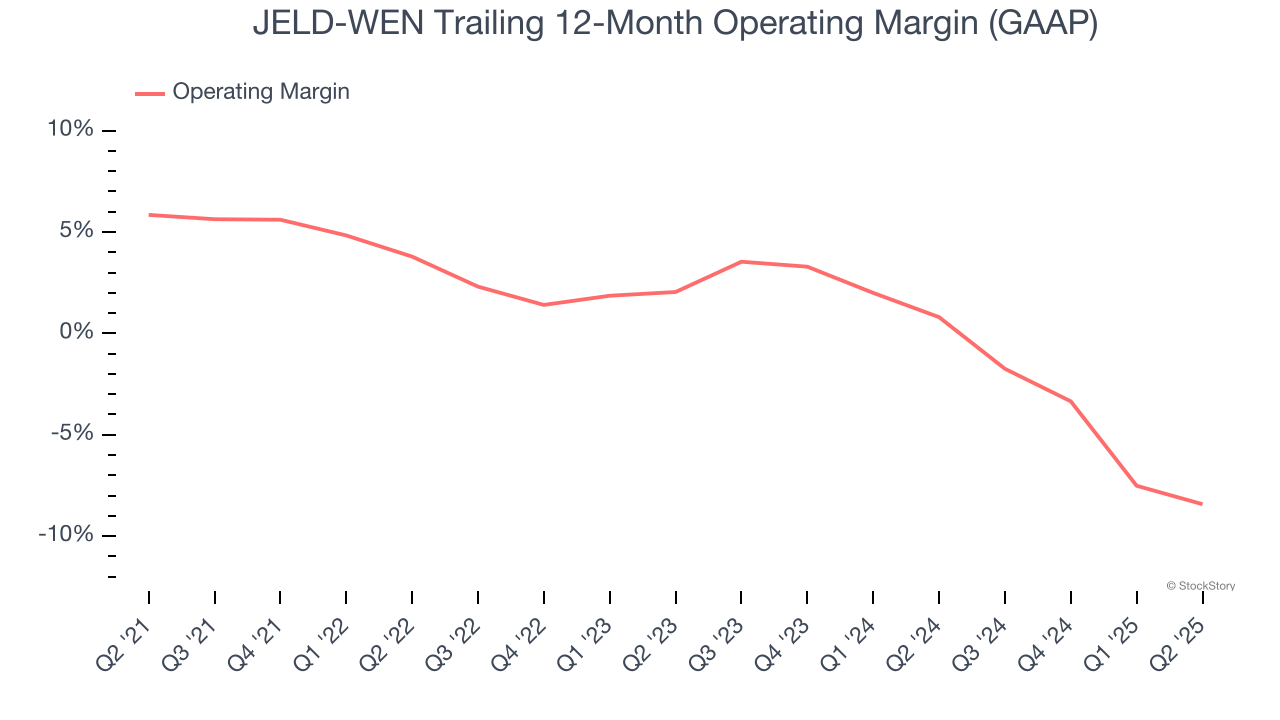
In Q2, JELD-WEN generated an operating margin profit margin of negative 1.7%, down 2.2 percentage points year on year. Since JELD-WEN’s operating margin decreased more than its gross margin, we can assume it was less efficient because expenses such as marketing, R&D, and administrative overhead increased.
Earnings Per Share
Revenue trends explain a company’s historical growth, but the long-term change in earnings per share (EPS) points to the profitability of that growth – for example, a company could inflate its sales through excessive spending on advertising and promotions.
Sadly for JELD-WEN, its EPS declined by 60.9% annually over the last five years, more than its revenue. This tells us the company struggled because its fixed cost base made it difficult to adjust to shrinking demand.
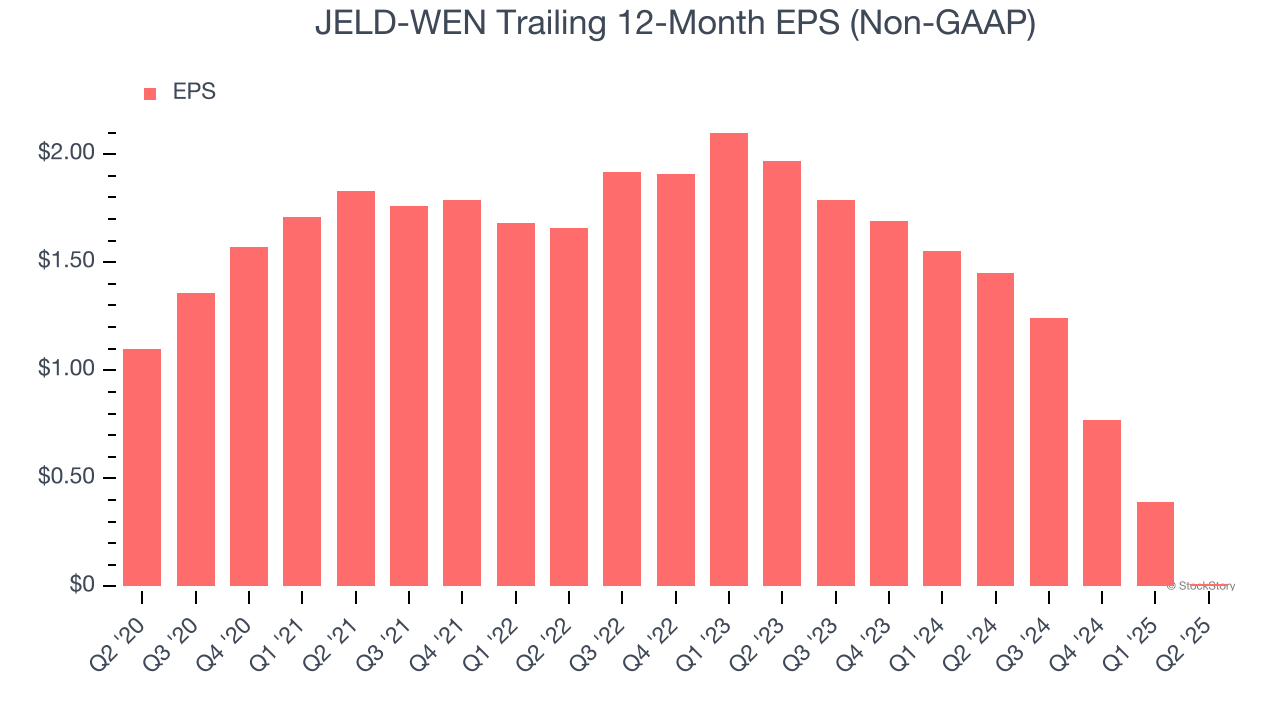
We can take a deeper look into JELD-WEN’s earnings to better understand the drivers of its performance. As we mentioned earlier, JELD-WEN’s operating margin declined by 14.3 percentage points over the last five years. This was the most relevant factor (aside from the revenue impact) behind its lower earnings; interest expenses and taxes can also affect EPS but don’t tell us as much about a company’s fundamentals.
Like with revenue, we analyze EPS over a shorter period to see if we are missing a change in the business.
For JELD-WEN, its two-year annual EPS declines of 92.9% show it’s continued to underperform. These results were bad no matter how you slice the data.
In Q2, JELD-WEN reported adjusted EPS at negative $0.04, down from $0.34 in the same quarter last year. Despite falling year on year, this print easily cleared analysts’ estimates. Over the next 12 months, Wall Street expects JELD-WEN to perform poorly. Analysts forecast its full-year EPS of $0.01 will hit $0.06.
Key Takeaways from JELD-WEN’s Q2 Results
We were impressed by how significantly JELD-WEN blew past analysts’ EBITDA and EPS expectations this quarter. We were also excited its full-year EBITDA guidance is nicely ahead of Wall Street’s estimates. Zooming out, we think this was a good print with some key areas of upside. The stock traded up 10.2% to $5.12 immediately following the results.
Indeed, JELD-WEN had a rock-solid quarterly earnings result, but is this stock a good investment here? If you’re making that decision, you should consider the bigger picture of valuation, business qualities, as well as the latest earnings. We cover that in our actionable full research report which you can read here, it’s free.




